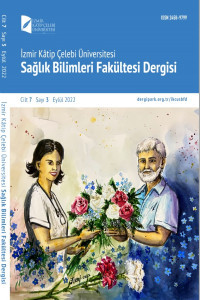Eğitiminin Başında ve Sonunda olan Fizyoterapi ve Rehabilitasyon Öğrencilerinin Beklenti ve Memnuniyet Düzeylerinin Karşılaştırılması
Anahtar Kelimeler:
Öğrenci, memnuniyet, beklenti, cinsiyet
___
- 667 karar sayılı Olağanüstü Hal Kapsamında Alınan Tedbirlere İlişkin Kanun Hükmünde Kararname. Erişim Tarihi: 10.07.2017. http:// www.resmigazete.gov.tr/eskiler/2016/07/20160723-8.htm.
- Arambewela, R., Hall, J., & Zuhair, S. (2004). Student satisfaction: impact of age and gender on satisfaction among international postgraduate students from Asia. Paper presented at the Virtue in marketing: proceedings of the Academy of Marketing Conference, 6-9 July 2004, University of Gloucestershire Business School.
- Asefi, F., Delaram, M., & Deris, F. (2017). Gap between the Expectations and Perceptions of Students regarding the Educational Services Offered in a School of Nursing and Midwifery. Journal of Clinical and Diagnostic Research: JCDR, 11(4), JC01.
- Bryant, J. L. (2006). Assessing expectations and perceptions of the campus experience: The Noel‐Levitz Student Satisfaction Inventory. New Directions for Community Colleges,2006(134), 25-35.
- d’Souza, M. S., Karkada, S. N., Parahoo, K., & Venkatesaperumal, R. (2015). Perception of and satisfaction with the clinical learning environment among nursing students. Nurse Education Today, 35(6), 833-840.
- Dimyati, M. (2015). The Role of Customer Satisfaction in Mediating Marketing Communication Effect on Customer Loyalty. Researchers World, 6(4), 75.
- Diniz, A. M., Alfonso, S., Araújo, A. M., Deaño, M., Costa, A. R., Conde, Â., & Almeida, L. S. (2016). Gender differences in first-year college students’ academic expectations. Studies in Higher Education, 1-13.
- Ekinci, C. E., & Burgaz, B. (2007). Hacettepe üniversitesi öğrencilerinin bazı akademik hizmetlere ilişkin beklenti ve memnuniyet düzeyleri. Hacettepe Üniversitesi Eğitim Fakültesi Dergisi, 33(33).
- El Ansari, W. (2003). Satisfaction trends in undergraduate physiotherapy education. Physiotherapy, 89(3), 171-185.
- Elliott, K. M., & Shin, D. (2002). Student Satisfaction: An alternative approach to assessing this important concept. Journal of Higher Education Policy and Management, 24(2), 197-209. doi: 10.1080/1360080022000013518
- Erden, A. (2015). Türkiye’deki fizyoterapi öğretim elemanlarının ve son sınıf öğrencilerinin fizyoterapi eğitimi ile ilgili memnuniyet düzeylerinin incelenmesi. Pamukkale Üniversitesi Sağlık Bilimleri Enstitüsü.
- Fontaine, K. (2014). Effects of a retention intervention program for associate degree nursing students. Nursing Education Perspectives, 35(2), 94-99.
- Kerridge, J. R., & Mathews, B. P. (1998). Student rating of courses in HE: further challenges and opportunities. Assessment and Evaluation in Higher Education, 23(1), 71-82.
- Mark, E. (2013). Student satisfaction and the customer focus in higher education. Journal of Higher Education Policy and Management, 35(1), 2-10.
- Mau, W. C., & Bikos, L. H. (2000). Educational and vocational aspirations of minority and female students: A longitudinal study. Journal of Counseling & Development, 78(2), 186-194.
- Mello, Z. R. (2008). Gender variation in developmental trajectories of educational and occupational expectations and attainment from adolescence to adulthood. Developmental Psychology, 44(4), 1069.
- Oliver, R. L., & DeSarbo, W. S. (1989). Processing of the satisfaction response in consumption: a suggested framework and research propositions. Journal of Consumer Satisfaction, Dissatisfaction and Complaining Behavior, 2(1), 1-16.
- Papathanasiou, I. V., Tsaras, K., & Sarafis, P. (2014). Views and perceptions of nursing students on their clinical learning environment: Teaching and learning. Nurse Education Today, 34(1), 57-60.
- Popli, S. (2005). Ensuring customer delight: A quality approach to excellence in management education. Quality in Higher Education, 11(1), 17-24.
- Saarinen, T. (2005). ‘Quality’in the Bologna Process: from ‘competitive edge’to quality assurance techniques. European Journal of Education, 40(2), 189-204.
- Shaw, A. (2013). Family fortunes: Female students’ perceptions and expectations of higher education and an examination of how they, and their parents, see the benefits of university. Educational Studies, 39(2), 195-207.
- Suarman. (2014). Gender Differences on Students Satisfaction: The Role of Teaching Quality in Higher Education. Middle-East Journal of Scientific Research, 21(9), 1434-1441.
- Ulusoy, H., Arslan, Ç., Öztürk, N., & Bekar, M. (2010). Hemşirelik öğrencilerinin eğitimleriyle ilgili memnuniyet düzeylerinin saptanması. Maltepe Üniversitesi Hemşirelik Bilim ve Sanatı Dergisi, 3(2), 15-24.
- Uzgören, N., & Uzgören, E. (2007). Dumlupınar Üniversitesi lisans öğrencilerinin memnuniyetini etkileyen bireysel özelliklerin istatistiksel analizi-hipotez testi, ki-kare testi ve doğrusal olasılık modeli. Dumlupınar Üniversitesi Sosyal Bilimler Dergisi, 17, 173-193.
- Weijters, B., Cabooter, E., & Schillewaert, N. (2010). The effect of rating scale format on response styles: The number of response categories and response category labels. International Journal of Research in Marketing, 27(3), 236-247. doi: http://dx.doi.org/10.1016/j.ijresmar.2010.02.004
- Whitt, E. J., Pascarella, E. T., Nesheim, B. E., Marth, B. P., & Pierson, C. T. (2003). Differences between women and men in objectively measured outcomes, and the factors that influence those outcomes, in the first three years of college. Journal of College Student Development, 44(5), 587-610.
- ISSN: 2458-9799
- Yayın Aralığı: Yılda 3 Sayı
- Başlangıç: 2016
- Yayıncı: İzmir Katip Çelebi Üniversitesi
Sayıdaki Diğer Makaleler
Sağlıkta Biyoistatistiksel Uygulamalar
Turhan KAHRAMAN, Devrim Can SARAÇ, Derya ÖZER KAYA
Senem ŞAŞ, Fatmanur Aybala KOÇAK
Hastanede Öğrencilere Verilen Oryantasyon Eğitiminin Etkinliğinin Değerlendirilmesi
Tuğba YILMAZ ESENCAN, Yeliz DOĞAN MERİH, Funda ÖZTÜRKAN ERDEK
Noktürisi Olan Yaşlı Hastalara Hemşirelik Yaklaşımı
Gülay GÖÇMEN AVCI, Gökşen ÖZTÜRK, Nihat AZAKLI, Serpil TÜRKER ÇEKİNMEZ
